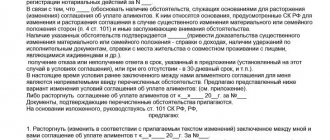Where to apply
| Name of the judicial authority | Competence |
| Magistrate's Court | He deals with:
|
| District Court | He parses:
|
Having decided on jurisdiction, it is necessary to deal with the issue of jurisdiction, i.e. determine the place where the trial will take place. To do this, you need to use the following legal rules:
- The interested party must file a claim document with the judicial authority located in the same locality in which the defendant is registered.
- However, a plaintiff who intends to divorce the defendant and collect child support payments from him may draw up a petition to change jurisdiction and submit it to the court at his place of residence. In the petition, he must write a valid reason why he asks to transfer the proceedings to his place of residence. These reasons include the plaintiff’s severe or chronic illness, for example, tuberculosis or kidney failure, and the maintenance of a minor citizen who cannot be left unattended.
- In addition, the parties to the divorce process can independently determine the city and judicial body in which they plan to resolve their differences. The agreement must be secured in writing.
Is it possible to file for divorce and alimony at the same time?
It is possible to dissolve a marriage and collect alimony at the same time, but to do this you will have to go to a district or city court. Previously, it was possible to apply to the magistrates' court , but now the rules have changed.
What is important to consider:
- The guardianship authority is involved in any disputes about children. His representative gives an opinion on the case.
- You can collect alimony not only for a minor, but also for a child over 18 years of age, as well as for the spouse with whom he remains. But strictly in certain cases.
- If the defendant objects to the separation, the court may give up to three months for reconciliation (Article 22 of the RF IC). This will significantly increase the duration of the divorce process. But if the plaintiff continues to insist on divorce after the reconciliation period, the decision will be made in his favor.
Note! If you need to get a divorce quickly, and both parties agree to this, it is easier to first apply to the magistrates' court for a divorce. In this case, a decision will be made in a month. Then you can collect alimony, but through the district.
Contents of the statement
According to Russian legislation, filling out a statement of claim must be carried out according to the template established by regulations. Any claim document contains three semantic parts:
- The upper part or, in other words, the “cap”. It contains the following information:
- The name of the judicial authority to which the applicant is sending his claims.
- Personal information about the plaintiff, including his last name, middle name and first name, contact information, for example, telephone, email, and his residential address.
- Personal information about the defendant, including his last name, middle name and first name, contact information, for example, telephone, email, and his residential address.
- Descriptive and motivational part. It states:
- Information about the time and place of the official marriage of the defendant and the plaintiff.
- Availability of children and details of documents confirming the fact of their birth.
- Reasons why spouses want to end their family relationship.
- There are disagreements about the future fate of the children. For example, this may be the disagreement of one of the participants in the marriage to leave the child with the other parent, a dispute over the future place of residence of the children, or a demand for deprivation of parental rights.
- The existence of an agreement between parents on the issue of child support for young children. If it is absent, then the plaintiff must indicate which of the spouses will be the alimony provider, and how much money he will be required to transfer monthly for the maintenance of young children.
An indication of the legal norms on the basis of which the plaintiff makes his claims.- Resolution part. It contains the following data:
- A list of demands presented, for example, dissolution of the marital relationship, change of surname and forcing the ex-spouse to pay alimony.
- List of documents and evidence attached to the application.
- The date the document was written with the signature of the originator.
How does the procedure work in court?
According to the provisions of Article 81 of the RF IC, if there is no agreement on the payment of alimony, then the issue is resolved in court.
The court must be guided by the following principles:
- both parents must bear equal costs of caring for their child;
- spouses must support it in equal shares, even if the fact of birth was recorded after the divorce;
- the court ruling is valid throughout Russia;
- payments must be made before reaching adulthood.
There is a strict procedure for payments, which is fixed in the current legislation. It is necessary to understand what you can count on in a particular case when applying for alimony.
What documents need to be attached
Along with the application, the plaintiff must submit the following documents to the judicial staff:
- A copy of the document that confirms the identity of the applicant.
- A certificate from the employer or a tax return certifying the amount of earnings of the parties to the litigation.
- A copy of the marriage certificate.
- Document confirming payment of state duty to the state treasury.
- Copies of certificates certifying the birth of common children.
- Certificate from the Migration Service of the Ministry of Internal Affairs about the current place of residence of the children.
- Agreement between parents on the amount of alimony, the procedure for maintaining and raising young children, if it was concluded.
- A petition to the court to request from the employer or the Federal Tax Service of Russia a certificate about the amount of the defendant’s earnings, if this document is not at the plaintiff’s disposal.
Features of divorce
A marriage can be dissolved through the court, regardless of the consent of the defendant. But if he objects, the time frame for consideration of the case may be delayed. When going to court, the marriage is considered dissolved from the moment the decision enters into legal force (Article 25 of the RF IC).
When considering a case, the court pays attention to several points:
- Reasons for divorce. It is not necessary to indicate them in the application, but if the defendant objects, the judge will definitely ask them.
- Who do the children stay with? This issue is resolved regardless of whether a request to determine their place of residence is submitted or not.
- The defendant's opinion. If he is against it and files a petition to set a conciliation period, he will have to wait up to three months for a decision.
In addition, during the divorce process it is possible to resolve the issue of division of property, but this will complicate everything and may increase the time for consideration of the case.
Amount of child support depending on the number of children
| Type of alimony payments | The procedure for calculating the amount of alimony |
| Share of earnings or other income of the alimony worker | The amount of money accrued for monthly payment by the alimony holder is:
|
| Hard money | Applies regardless of the number of children if:
|
Submission deadlines
Consideration of a case in court is a rather lengthy process. It may take several months. At the same time, the authority has the right to set a period of 3 months for reconciliation of the parties. This measure can help save the family, which is important when you have a baby.
The case may also be extended if one of the parties to the dispute submits a motion. The reason may be a search for new evidence or a banal illness of the participant.
If during the consideration of the case the parties do not reconcile, the authority makes a decision to divorce. In this case, the interests of the heir are taken into account.
Amount of duty
Before transferring the claim and the documents and evidence attached to it to the court officials, the applicant is obliged to pay 600 rubles. for the provision of judicial services for divorce.
The Tax Code determines that the state duty for alimony cases is 150 rubles. However, the plaintiff, who requires the defendant to fulfill alimony obligations, has a benefit, according to which alimony cases are considered by the court free of charge. If the trial ends in favor of the plaintiff, 150 rubles. state fees will be forcibly collected from the defendant.
Consideration of the claim
After the application with accompanying documents has been submitted by the plaintiff to the court officials, the judge has 5 days to make a ruling initiating the start of the divorce process or perform the following actions:
- Refuse the plaintiff to accept the claim until he corrects the deficiencies found in the application.
- Return the documents to the applicant.
- Refuse to consider claims.
Keep in mind that claims aimed at forcing the child support provider to make payments must be resolved within one month from the date the judge accepts the document of claim.
After accepting the case for consideration, the judge sets a date for a preliminary hearing, during which the following occurs:
- Resolution of motions of participants in the trial.
- Clarification of claims and submission to the court of objections prepared by the defendant.
- A proposal by a judge addressed to the parties to a proceeding to resolve differences by mutual agreement.
- The judge separates different claims or combines the plaintiff’s claims into one claim.
- The judge determines the date of the next hearing.
The trial of a dispute between spouses goes through the following stages:
- The judge opens the hearing, then checks the presence of persons taking part in the case in the courtroom, explains to them their duties and rights, and asks the witnesses to leave the courtroom.
- The judge explains to the parties the rules by which they can challenge judges and considers the submitted requests.
Before resolving the spouses' differences on the merits, the judge asks the defendant whether he wants to recognize the plaintiff's claims. In case of refusal, invites the parties to draw up and sign a mutual settlement agreement.- If a peaceful resolution of the dispute is refused, the judge begins the consideration of the case by listening to the explanations of the defendant and the plaintiff.
- He then listens to witnesses and examines the evidence presented by the parties.
- To make sure that it makes no sense to continue the official marriage, the judge examines the facts confirming the impossibility of living together for the married couple. These include testimony from witnesses that the wife and husband do not live together in the same living space, certificates from the migration service about the place of residence of the spouses.
- When resolving marital disagreements regarding the place of residence and upbringing of young children, the judge carries out the following actions:
- Interviews the child, studies his interests and affection for each parent.
- Looks at the behavior of spouses and evaluates their personal qualities.
- Examines certificates of parents' earnings.
- Evaluates the list of material assets belonging to each parent.
- This is necessary to understand which member of the couple will be able to provide the child with more favorable opportunities and living conditions in the future.
- Listens to the opinion of a representative from the guardianship authority.
- When deciding the amount of alimony, the judge takes into account the following facts:
- The amount of money the defendant receives as salary or other income.
- Number of common minor children.
- Lack of monetary contributions to the plaintiff from the defendant.
- After the examination of evidence is completed, the stage of judicial debate begins. Each side is given time to make a speech in defense of its claims.
- The judge leaves the courtroom and goes to the deliberation room, where he is engaged in developing a decision.
- The judge publicly announces the decision.
The part of the decision that concerns the resolution of the alimony dispute must be implemented immediately after it is announced by the judge.
The decision on the issue of termination of family relations is given legal force one month after it is made in final form and only if the losing party has not filed an appeal.
Arbitrage practice
The case was considered by the Alushta City Court of the Republic of Crimea in June 2015.
The wife sent a statement to the court in which she asked:
- Dissolve the marriage with the defendant, change the surname to the premarital one.
- Oblige the husband to pay monthly alimony contributions for the common child until he reaches 18 years of age.
- Ensure your own maintenance at the expense of your husband until their common child turns 3 years old.
The wife motivated her claims as follows:
- It makes no sense to continue the marriage relationship, since the married couple has actually broken up, does not live together and is not involved in running a common household.
- The husband does not want to resolve the issue of alimony by mutual agreement.
- Her own maintenance is necessary because she is busy caring for the baby. Because of this, she has no time to work.
The defendant, in response to the plaintiff’s claims, stated that he agreed to separate from his wife, but would not give her money, since she would spend it on herself. Instead, he proposed this option: he would independently purchase everything necessary for the baby. He also explained that he works in a taxi company, so his earnings are irregular.
Having considered the circumstances of the case, the court came to the following conclusions:
- It is necessary to end the family relationship of the spouses, since this does not contradict their wishes and the law.
- Partially acknowledge the wife's demands regarding child support. Since the income of taxi drivers is unstable, the payment of alimony obligations should be awarded in a fixed amount. Reduce the amount of alimony claims from 6 thousand rubles. up to 4.5 thousand rubles.
- The defendant should be required to pay his ex-wife 2 thousand rubles monthly. on its content. Since the husband’s family financially supports the plaintiff, for example, clothes and feeds her child, pays for her studies at the university, the judge came to the conclusion that there are no reasons to award a larger sum of money than 2 thousand rubles. for financial support of the spouse.
Cost and methods of payment of state duty
It is necessary to understand that the amount of the fee directly depends on the cost of the claim. But if there are no property claims in it, then the cost of circulation is established by law.
| State duty amount | What is the payment for? |
| 650 rubles for each spouse | For divorce in court |
| 150 rubles | For filing a claim for the recovery of alimony in favor of a child |
| 300 rubles | If the claim involves the recovery of alimony in favor of the child and yourself |
| 400 rubles | If one claim includes a demand for divorce and alimony |
There are several payment methods, namely:
- At the service office of any bank. To do this, you must provide your passport and payment details. The commission can be up to 2% of the amount.
- Via Internet banking. You will also need to enter your details. If the recipient's bank does not differ from the payer's bank, then there may be no commission.
- Use of electronic wallets. The essence of the method is completely the same as payment via Internet banking, but a different payment system is used. The commission is usually up to 5%.
- Payment through special terminals. The commission can be up to 10% of the amount.
Depending on the chosen payment method, funds may be credited to your account from 1 day to 5 days.
The legislative framework
| Title of the legal act | Articles |
| Family Code of Russia |
|
| Civil Procedure Code of Russia |
|
| Tax Code of Russia (part 2) |
|
Legal basis
Russian legislation contains clear rules on family relationships expressed in the following standards:
- Family Law;
- Civil Procedure Code of the Russian Federation.
Their main task is to protect the interests of the child. The content of the articles of these documents does not prohibit simultaneously filing a claim for divorce and alimony, if both of these requirements are specified.








